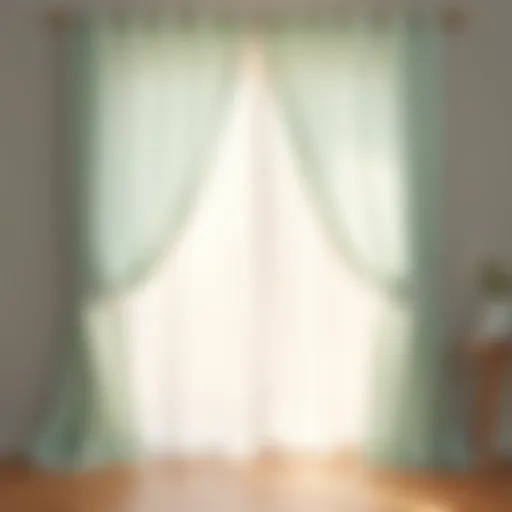A Comprehensive Guide to Replacement Closet Shelves
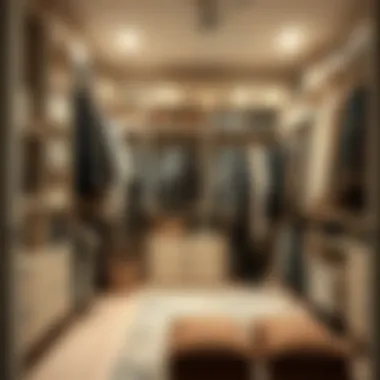
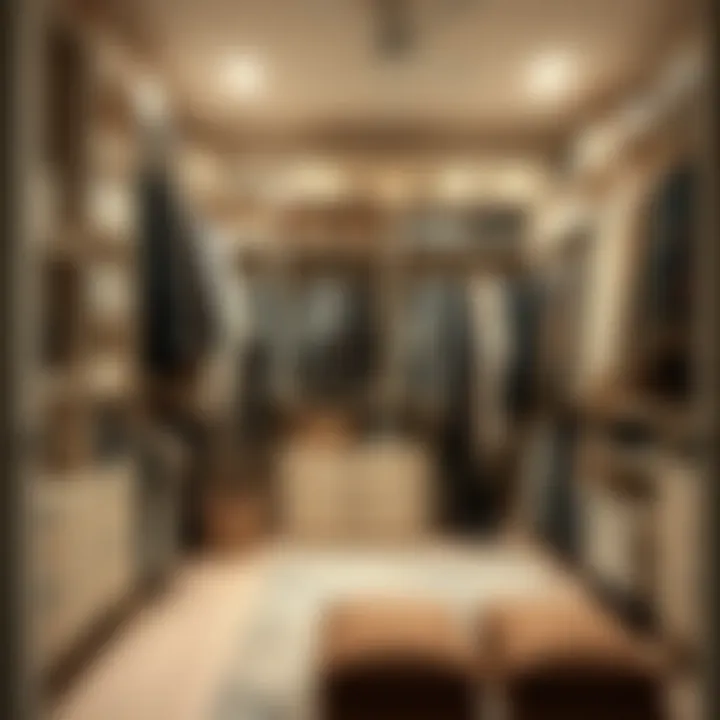
Intro
Replacement closet shelves can be a game changer for organizing your space. Whether you're tackling a cramped hall closet or overhauling a master bedroom walk-in, the way you choose to store your items can dramatically affect both utility and aesthetics. With growing trends in home organization and design, many homeowners are rethinking their shelving solutions to better meet their needs.
In this guide, we will explore several dimensions of replacement closet shelves, from the latest styles and materials to installation tips and maintenance advice. Along the way, we'll provide insights tailored for a variety of budgets, ensuring everyone can find a solution that works for them.
Understanding how to maximize your storage efficiency while also enhancing the visual appeal of your space can seem daunting, but we’re here to simplify the process.
Furniture Design Trends
Current Styles and Aesthetics
The aesthetic value of closet shelves has evolved far beyond mere functionality. Nowadays, homeowners prioritize not just practicality but also design. Open shelving, for example, has gained traction. This style invites a sense of openness while providing an opportunity to display stylish storage bins or neatly folded clothes.
On the other hand, enclosed shelving is still popular, offering clean lines and a more refined look. Sliding doors or double doors can also cater to different preferences, enabling you to keep the clutter out of sight. Some contemporary styles feature modular systems that allow customization.
Key Trends to Consider:
- Open vs. Enclosed Shelving: Open designs promote visibility and accessibility, while enclosed options keep dust at bay.
- Modular Units: Customizable modules can adapt to different closet shapes and sizes, making them highly versatile.
- Natural Elements: Materials like bamboo and reclaimed wood are making a comeback, emphasizing eco-friendliness while adding warmth to a space.
Color Palettes and Materials
When it comes to colors, neutrals dominate but are increasingly contrasted with bolder, statement hues. Consider combining white or gray shelves with darker accents for a striking effect. Meanwhile, the texture of materials also plays a vital role; smooth finishes can create a sleek modern feel, while rough-hewn surfaces may provide a rustic charm.
Some popular materials for replacement shelves include:
- Plywood: Affordable and sturdy, ideal for DIY projects.
- MDF (Medium-Density Fiberboard): Great for a smooth finish, often painted or coated.
- Solid Wood: Offers durability and an upscale appearance but comes at a higher price point.
"Choosing the right material is as essential as the design; a blend of function and form ensures longevity and visual appeal."
In summary, the current trends in closet shelf design speak to a balance of aesthetics and practical use. Understanding which styles, colors, and materials resonate with your personal taste can help guide your choices in creating a closet that fits both your lifestyle and your home décor.
Buying Guides
Essential Considerations When Purchasing
When stepping into the realm of replacement closet shelves, several factors ought to be weighed carefully:
- Storage Needs: Assess what needs to be stored. Do you have bulky items or just lightweight clothing?
- Closet Dimensions: Accurate measurements are crucial. Don’t forget to account for height and depth.
- Budget: Know in advance how much you are willing to invest, as the price can vary widely based on the material and design.
- Installation Type: Will you go for easy DIY installations, or hire a professional?
Top Recommendations for Different Budgets
Finding the right shelves doesn't have to break the bank. Here is a range of options for various budget levels:
- Budget-Friendly:
- Mid-Range:
- High-End:
- ClosetMaid ShelfTrack - A sturdy option that offers great value for its functionality.
- Rubbermaid Configurations - A customizable system with stylish options perfect for closet organization.
- California Closets - Offers premium materials and design services for a tailor-made solution.
By keeping these considerations in mind, you can navigate your options more effectively and ensure that your new closet shelves not only meet your functional needs but also complement your home's overall aesthetic.
Understanding Closet Shelving
Understanding closet shelving is the keystone of an organized living space. With the right shelving system, you can not only enhance the utility of every inch of your closet but also turn clutter into a functional work of art. Identifying how different shelves can serve your individual needs makes all the difference. It’s about assessing available space while maintaining the right flow in your closet.
Closet shelving can be the key to maintaining an organized environment. Think of it this way, the shelves are like the skeleton of your storage; they hold everything together, giving structure and support. In this guide, we will delve into various types of closet shelving and their features, ensuring you have the tools to excel in your storage endeavors.
Types of Closet Shelving
When diving into the myriad of options available for closet shelving, knowing the types can either make your selection a breeze or turn it into a whirlwind of confusion. Each type comes with specific advantages suitable for various needs. Here are a few that stand out:
- Fixed Shelves: These shelves are securely placed, offering stability for heavier items like shoes or boxes. They stay put, providing a solid foundation tailored for long-term storage.
- Adjustable Shelves: Imagine having the freedom to change your mind at any moment. Adjustable shelves can be repositioned to maximize space for taller items, such as boots or stacked bins. They adapt as your storage needs evolve.
- Wire Shelves: Often seen in kitchen pantries or laundry rooms, wire shelves are lightweight and allow air circulation. They’re fantastic for items that benefit from ventilation, such as towels or clothing.
- Corner Shelves: Those tricky corners in your closet can be transformed with corner shelving. They maximize unused space and allow for creative organization of smaller items.
- Floating Shelves: Mounting shelves directly to the wall, these beauties offer a sleek, modern touch while also being functional. Great for decorative purposes or displaying essentials within reach.
In understanding the available types, one can better match their choice with personal storage requirements.
Key Features of Replacement Shelves
When you’re delving into the world of replacement closet shelves, recognizing the key features can make a monumental impact on both form and function. Here are essential aspects to consider:
- Weight Capacity: It’s crucial to know how much load each shelf can bear. Overloading shelves can lead to breakage. Always check the manufacturer's specifications.
- Material Quality: Whether wood, metal, or plastic, the material affects durability. For example, solid wood provides robust support but might not be suited for wet environments like basements. Metal shelves, on the other hand, are resistant to moisture.
- Finish Options: Aesthetics meet functionality here. If you’re looking to blend your shelving with closet decor, finish options such as laminate or paint can offer the perfect touch.
- Ease of Installation: Some shelves are designed for quick assembly, making them a good choice for DIY enthusiasts. However, others may require additional tools or support, which is important when planning your installation.
- Compatibility: Always check if the replacement shelves are compatible with existing systems or brackets. This ensures that you have a seamless integration into your current setup.
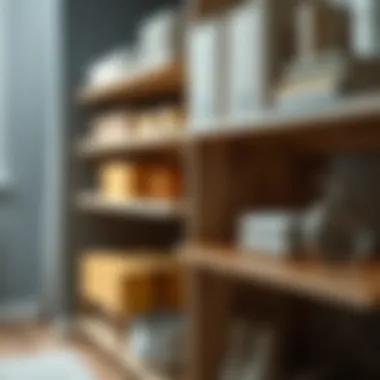

"Choosing the right replacement shelves isn't just about look – it’s about how well they fit into your life".
Adopting these considerations ensures that your selection process transforms into a more informed, confident decision, guiding your closet organization aspirations into reality.
Evaluating Material Options
When it comes to replacing closet shelves, choosing the right material is like picking the right paint color; it sets the tone for the entire space. Evaluating material options isn’t just a technical decision; it’s about aesthetics, functionality, and longevity. The shelf you choose impacts not only how your closet looks but also how well it meets your specific needs. A good selection can help maximize your storage capabilities while ensuring your belongings are safely stowed away and easily accessible.
Key considerations when evaluating materials include:
- Durability: How well will the shelves withstand weight and wear?
- Cost: What’s your budget, and how does each material fit within it?
- Maintenance Needs: How easy will it be to keep these shelves looking good over time?
Understanding these elements can help you make a confident choice, whether you're a DIY enthusiast ready to roll up your sleeves or a homeowner seeking professional installation.
Wood vs. Metal Shelves
Wood and metal shelves each bring their unique charm and functionality. Wood shelves often offer a warm, classic aesthetic that can transform a closet into something inviting. They can handle a good deal of weight, depending on the type of wood used. For instance, solid hardwood like oak is generally robust, while engineered options like MDF might be lighter on the wallet but need a bit more care when it comes to heavy items.
On the flip side, metal shelves are the fortress of storage solutions. Known for their strength and resilience, they hold significant weight without warping or bending under pressure. This makes them ideal for items like heavy tool kits, books, or large storage bins. The sleek, modern designs of metal shelving can also suit contemporary decor themes quite well. However, keep in mind that metal may not always provide the warm aesthetic that some homeowners prefer.
"The right shelving material not only enhances your closet’s utility but plays a significant role in defining your personal style."
In choosing between wood and metal, reflect on both taste and need. Factor in how you plan to use your closet and the overall look you wish to achieve.
Plastic Shelving: Durability and Cost
Plastic shelving often flies under the radar when it comes to material evaluations, but it shouldn’t be overlooked. One of the most significant advantages of plastic is its lightweight nature, making installation a breeze for even the less experienced DIYers. This material tends to come at a lower cost than wood or metal, allowing you to save bucks while still enhancing functionality.
In terms of durability, plastic has come a long way. Modern plastic shelves are made to be tough, often resistant to moisture and decay, making them suitable for areas prone to humidity, like laundry rooms or basements. However, it's crucial to note that while they can hold light to moderate weight effectively, heavy items should be avoided, as they might cause bending or sagging over time.
To sum up, when considering plastic shelves, it's pivotal to evaluate:
- Weight Limit: Ensure it fits your storage vision.
- Exposure: Consider where you’ll place them (moisture, heat, etc.).
By weighing these options carefully, you can ascertain which materials will best serve your needs while brightening up your closet space. Making an informed choice not only streamlines your organization process but also keeps the clutter at bay.
Assessing Your Storage Needs
When it comes to selecting replacement closet shelves, understanding your storage requirements is crucial. This step sets the foundation for a personalized and efficient shelving solution. Regardless of the size and scope of your closet, knowing what you need to store can aid significantly in determining the best shelving options. The right shelves can turn a cluttered space into a well-organized haven, but neglecting to assess your needs could result in wasted space and frustration.
The process of evaluating your storage needs involves several key elements. One of the most important is getting a thorough inventory of what you plan to store. This not only dictates the type of shelving you choose but also influences dimensions, weight load considerations, and placement within your closet.
Moreover, it’s vital to remember that an effective shelving system doesn't just hold items; it also enhances accessibility and visibility. Hence, knowing your storage needs can lead to a more functional space that reflects your lifestyle and efficiency.
Inventory of Belongings
Conducting an inventory of your belongings is akin to going on a treasure hunt through your closet. You’re not just clearing clutter; you're taking stock of what you truly have. Begin by removing everything from the closet. As odd as it sounds, this method reveals hidden gems — items that may have been forgotten for ages. List everything you uncover, from shoes and clothes to accessories and seasonal gear.
- Categorization: Group similar items together. Clothing, shoes, seasonal decorations, and sports equipment each come with their own storage needs.
- Evaluate Necessity: As you compile your inventory, ask yourself: "Do I need this? Have I used it in the past year?" Items that no longer serve a purpose can be donated or discarded, ultimately freeing up valuable space.
- Measurements: Once you've determined the items you want to keep, take measurements of various pieces. This helps you identify the types of shelves you need based on the sizes of your belongings.
This process not only simplifies the subsequent steps in installing replacement shelves but also helps visualize the potential setup for your closet, ensuring decisions are made based on actual needs rather than whims.
Weight Capacity Requirements
Understanding the weight capacity requirements of your shelves is equally significant. This aspect often flies under the radar but can spell disaster if overlooked. Each shelve’s material and design dictate how much weight it can bear. Picture this: you decide to stack heavy boxes on a flimsy shelf, and the resulting collapse sends everything tumbling to the floor. It's not just about aesthetics; it's about ensuringlong-term functionality.
Here are some important considerations:
- Material Matters: Different materials offer different tensile strengths. For instance, solid wood shelves typically support more weight compared to particleboard. Understand the limits of the materials you’re working with.
- Design Considerations: The width and thickness of the shelves play a role too. Wider shelves require more support, while thicker shelves can usually carry more weight.
- Load Distribution: Always think about how you'll allocate weight across your shelves. Stacking heavier items towards the bottom and lighter ones above can significantly enhance stability.
In sum, keeping the weight capacity in mind while planning your closet shelving can save you from future headaches and ensure that your closet remains not only organized but also safe.
"Assessing storage needs isn't just about acquiring shelves; it's about crafting a functional and sustainable storage environment that fits your life."
By systematically evaluating your belongings and their weight requirements, you not only streamline your storage solutions but also create an efficient organization that brings clarity to your living space.
Design Considerations for Replacement Shelves
Designing the right shelving system is not merely about filling space; it’s a pivotal part of creating an organized and functional closet. When you consider replacement shelves, it’s essential to think about how they will serve your specific needs—after all, a well-designed system can significantly enhance both accessibility and aesthetics. Proper design directly correlates to maximizing storage potential and ensuring your closet remains tidy and user-friendly.
Shelf Depth and Height
Determining the depth and height of your shelves is more than just guesswork; it plays a significant role in efficiency. Standard shelf depth typically ranges from 12 to 24 inches. Choosing the right depth depends largely on what you plan to store. For instance, a depth of 16 inches may suffice for folded clothes, whereas shoes or larger items may need at least 24 inches.

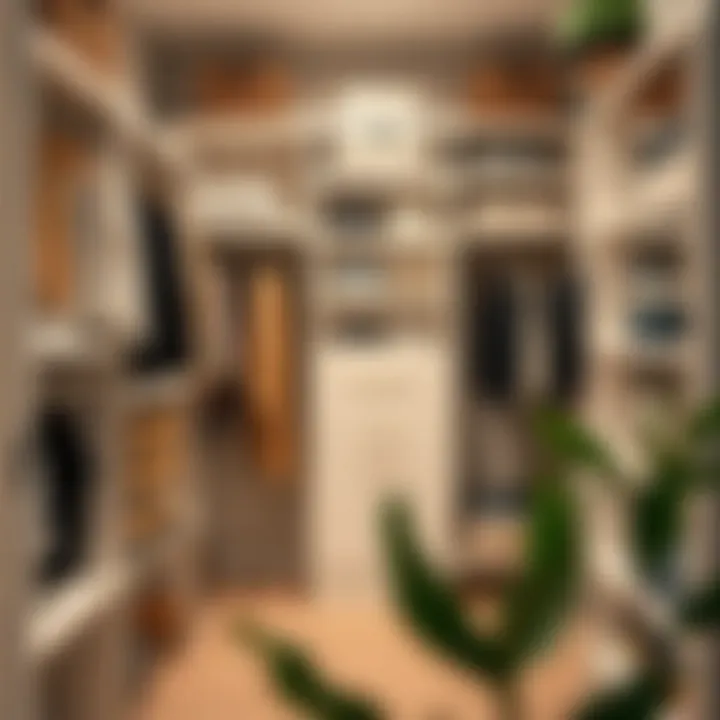
Height considerations, on the other hand, can drastically change how items are stored and retrieved. Ideally, shelves should offer enough vertical space to accommodate items without causing inconvenience or clutter. A common recommendation is to space shelves about 12 inches apart, striking a balance between visibility and access. However, this may vary when you're thinking about taller objects, like winter coats or stackable bins.
Moreover, if you have small children or pets, consider shelf height placement that they can’t reach. Conversely, if you have a high ceiling, take full advantage by incorporating taller shelving units. This not only makes use of vertical space but can also create an illusion of a larger room, which is useful in a compact residence.
"The height of your shelves may define the reach of your organization. Too high, and you might as well store your items on the moon. Too low, and you lose valuable space that could otherwise be utilized."
Configuring Space for Various Items
The arrangement of your shelves can make or break the closet experience. When configuring spaces, think about the variety of items you’ll place in your closet. In a well-thought-out design, items should not only fit but also complement each other in terms of visibility and accessibility.
Consider these configurable zone principles:
- Zone Ahead: Identify the primary use of each shelf. For folded clothes, a wider-space layout might work best; whereas a shoe shelf would benefit from smaller divisions.
- Accessibility First: Items you use more frequently should be at eye level or below. For those you seldom access, take a higher approach.
- Mix It Up: Don’t hesitate to combine open and closed storage solutions. Baskets on lower shelves can hide items, while boxes on higher shelves might store seasonal items like holiday decorations.
Ultimately, having a clear idea of how you want to utilize the closet space allows you to determine the ideal configuration. Pay attention to how the spacing affects your daily routine. If you constantly need to rearrange items to find what you need, it’s likely time for a redesign. Finding that sweet spot of both aesthetic beauty and functional efficacy is the ultimate aim.
For further insights into effective closet organization, check out This Old House or Wikipedia on Closet Systems.
Installation Techniques
Installing replacement closet shelves is not just about putting up planks of wood or metal. It’s a pivotal step that can make or break the effectiveness of your storage solution. Proper installation techniques ensure that your shelves can support the intended load while maximizing space efficiency. Moreover, the right approach can enhance the aesthetic appeal of your closet, turning it into a well-organized and visually pleasing area rather than just a storage space. Understanding both DIY approaches and when to seek professional help is crucial, so let’s dive deeper into these avenues.
DIY Installation Process
Undertaking a DIY installation of your closet shelves can be a rewarding experience. It allows you to customize the layout according to your specific needs while saving some bucks in the process. However, it's essential to approach this task with a clear plan.
- Preparation: Before rolling up your sleeves, gather necessary tools and materials. A level, measuring tape, mounting brackets, and screws are fundamental. Additionally, consider the type of shelf material and brackets that fit your design.
- Planning Layout: Consider the weight of items you'll store. Ensure that the depth and spacing of shelves accommodate various items without overcrowding. Draw a basic sketch of the layout. Where will the heavy stuff go? Where can you fit in smaller items?
- Mounting Process: Start by securely attaching the brackets to the wall. Using a level is key here; this prevents your shelves from tilting, leading to potential hazards. Once multiple brackets are in place, lay the shelves on top, fixing them as needed. Pay attention to the manufacturer’s guidelines—each shelf type has its own instruction.
- Finishing Touches: Once installed, step back and take a look. Could anything be adjusted? Perhaps adding decorative storage boxes or a coat of stain for wooden shelves to align with your interior décor? Don’t overlook the final tweaks that can elevate function and form.
- Tip: If you're unsure about measurements, it's better to measure twice and cut once.
"A well-installed shelf is like a sturdy foundation for a house—it’s essential to its stability and longevity."
Engaging in this process not only empowers you but also teaches skills that can be useful in future home improvement tasks. Yet, it’s crucial to recognize when the task exceeds your capability. Let’s explore the option of hiring professionals next.
Hiring Professional Installers
Sometimes, there’s just not enough time in the day, or perhaps the installation feels beyond your comfort level. In such cases, hiring professional installers can relieve a lot of stress. Here’s why opting for pros can be beneficial:
- Expertise: Professionals come with the experience and knowledge to handle a variety of installation scenarios. They understand different materials and configurations, ensuring that everything is installed safely and effectively.
- Tools and Equipment: Many DIY enthusiasts find themselves short of specialized tools—this is where pros have the upper hand. They arrive equipped with all necessary tools and know how to use them properly, ensuring a smooth process.
- Time Efficiency: Instead of devoting an entire weekend to the task, professionals can get it done relatively quickly. This is especially crucial if you’re planning to complete other home renovations simultaneously.
- Guaranteed Work: Hiring professionals often comes with a guarantee on their work. You can rest easy knowing that if issues arise, you can reach out to them for solutions.
While considering hiring professionals, it’s wise to do some legwork. Get multiple quotes and check references. Ultimately, ensuring that you make an informed choice can help you avoid any future hiccups.
Maximizing Closet Space
Maximizing closet space is a game changer in today’s increasingly cluttered homes. Every inch of storage can be crucial, especially for homeowners who have a multitude of items that need a proper place. Once you take stock of what you own, you quickly realize how easily your closet can turn into a black hole where things go to vanish. Effective closet shelving can help transform that disarray into a neatly organized sanctuary.
By effectively utilizing space, you’re not just freeing up room for new belongings; you’re also enhancing the overall functionality of your closet. Suppose you have a well-designed shelving system. In that case, you can quickly locate your favorite shoes, jackets, or holiday decorations without digging through a mess. Plus, the right choices in shelving can make your closet not only more organized but visually appealing as well.
Vertical Space Utilization
When it comes to closets, the sky’s the limit—literally. Vertical space is often underutilized, yet it presents a wealth of opportunity. Most closets have high ceilings, which provide ample vertical space for additional shelving.
One practical approach to maximizing this vertical area involves installing shelves higher up, making them accessible only for items you seldom use, like seasonal clothing or luggage. This way, the lower shelves can be devoted to everyday essentials, allowing for easy access. Consider using:
- Tall shelving units: These can reach near the ceiling without overwhelming the space. They are great for storing boxes or bins that can hold less frequently used items.
- Ladder shelves: A bit of a quirky twist, these can add flair while utilizing vertical space effectively—angle them against a wall and display various items on different levels.
- Wall-mounted units: These don’t even touch the floor but can hold that extra weight you need off the ground.
It's really about playing Tetris with what you have. The more you stack and layer, the better you can organize your belongings. What’s more, the right installation can give the illusion of a bigger, airier space, which is a bonus for smaller rooms.
Organizational Tools Integration
After you've accounted for the vertical dimensions, the next step is to incorporate organizational tools that can further refine your closet’s capabilities. Think of tools as the accessory to your shelving—no outfit is complete without them. Integrating these can significantly boost your storage potential and keep items orderly.
Here are a few organizational tools you might consider:
- Baskets and Bins: These can create a quick solution for storing smaller items that otherwise lay around. Bins can stack neatly on shelves without causing a domino effect of clutter.
- Shelf Dividers: If you’re storing clothing, having dividers can help keep items like sweaters from toppling over, preserving the neatness of your piles.
- Hooks and Racks: Installing hooks on the inside of a closet door can provide a useful place for items like belts, bags, or even jewelry.
- Vertical Storage Containers: These allow you to take full advantage of height, making smaller items easier to find and access.
Incorporating organizational tools doesn't merely tidy up the space; it allows you to see all of your items clearly, reducing frustration when you’re looking for specific things.
"Organized spaces lead to organized minds—an investor’s best strategy for the home."
In sum, maximizing closet space is all about thoughtful planning and choosing effective shelving and organizational solutions that cater to your unique needs. By harnessing vertical space and integrating practical tools, you’ll transform what was once a cluttered closet into a paragon of efficiency.
Maintenance and Care for Closet Shelves
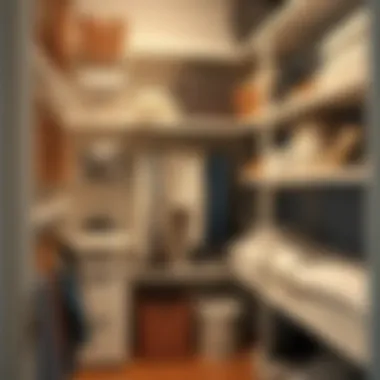
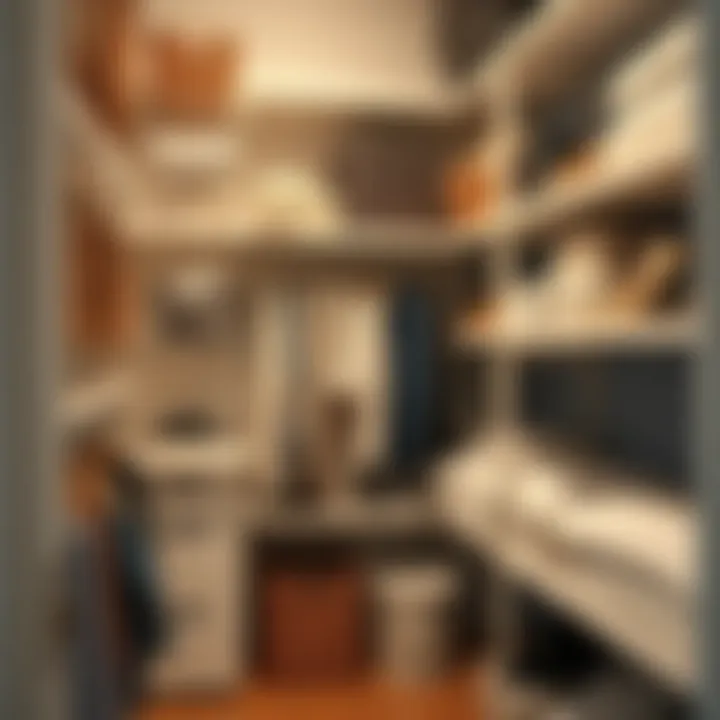
When it comes to keeping your closet shelvess in prime condition, maintenance and care play a crucial role. Not only do well-maintained shelves enhance the longevity of your investment, they also ensure that your stored items remain safe and in good shape. After all, a closet is more than just a space for storage; it reflects your organization skills and contributes to the overall aesthetic of your room. By dedicating some time to maintain your shelves, you can avoid costly repairs and replacements down the line, ensuring your closet remains a pillar of order and functionality.
A regular maintenance schedule allows you to address wear and tear before it escalates. Understanding the specific cleaning and care requirements of various materials can make all the difference. For instance, wooden shelves might demand more attention than metal ones simply due to their susceptibility to moisture and scratches. Each material calls for a tailored approach in order to preserve its integrity.
"Neglect often leads to regret; taking care of your shelves is the first step to an organized life."
Additionally, setting up a periodic check system not only helps catch issues early but also nurtures a habit of organization within your household. Such vigilance fosters a space that not only looks good but is also functional at its best.
Cleaning Guidelines
Regular cleaning is essential to keeping closet shelves from becoming dust-collecting monstrosities. A simple yet effective routine can keep them in tip-top shape:
- Dusting: Use a soft cloth or microfiber duster to sweep away dust and debris from each shelf. This should be done at least once a month, though more frequent cleanings can keep allergens at bay.
- Stain Removal: For stained areas, a damp cloth with a mild soap solution can do wonders. Ensure to dry it off immediately if using wood to avoid warping.
- Surface Protection: Consider applying a protective coat for wooden shelves, especially if they bear heavy items or are regularly exposed to moisture. Products like silicone sprays or beeswax can create a barrier against scratches and stains.
Keep in mind that the cleaning approach might differ based on the shelf material. For instance, metal shelves usually require less intensive care than wooden ones. If corrosion is a risk, wiping down metal shelving with oil is a good preventative measure to avoid rusting over time.
Periodic Checks and Repairs
Conducting periodic checks is more than just a formality; it's a proactive way to ensure longevity in your shelving system. Here are some steps to incorporate into your regular maintenance routine:
- Inspection: Every few months, inspect each shelf for signs of damage or sagging. Look out for cracks, warping, or rust spots, particularly in wooden or metal shelving.
- Reinforcement: If any shelf shows signs of sagging, it may need additional support. This could mean relocating books or heavy items to a lower shelf or adding brackets for sturdiness.
- Fastener Checks: Ensure that screws, brackets, and nails are tightly secured. Loose fasteners can affect stability and lead to more significant issues if left unchecked.
- Repairs: Addressing minor issues like scratches or dents promptly can prevent them from evolving into bigger problems. A wood filler can remedy small cracks, while a coat of paint might cover superficial rust on metal.
By embedding these simple practices into your routine, you will create a sustainable approach to maintaining your closet shelves. Your investment in time and care will not only sustain functionality but also enhance the overall organization of your space, ensuring it remains a reliable hub for your belongings.
Cost Considerations
When embarking on a project to update or replace closet shelves, understanding the cost considerations is a crucial step. Many homeowners might approach this without realizing the underlying factors that contribute to the total expense involved. From material choices to installation methods, each decision affects not just the budget, but also the effectiveness and longevity of the shelving. This section will cover the essential elements you need to keep in mind while contemplating your closet shelving needs, ensuring you make informed financial decisions that align with your overall goals.
Comparative Pricing of Materials
The market today offers an array of materials for closet shelves, each with its own price tag. Typically, wooden shelves, like those crafted from pine or oak, can be on the higher end due to both aesthetics and durability. A solid wood shelf might run between $15 to $50 each, depending on the type and quality. On the other hand, metal shelves can be a more affordable choice, typically costing anywhere from $10 to $30 per shelf, and providing a sleek, modern look while being quite durable.
Then there's plastic shelving, often seen as the budget-friendly choice. These shelves can cost as little as $5 to $20, yet while they excel in keeping costs down, their longevity is usually not on par with wood or metal options. Additionally, there’s the potential for weight limitations and flexibility issues with plastic, which can lead to unexpected costs down the line if replacement is necessary.
Consider this: Budget isn’t just about the initial purchase. Think about the lifespan of the material and the potential need for replacements in the future. Spending a bit more initially on something sturdy might just save you in the long run.
You'll also want to factor in other costs like shelving brackets, which may run for an additional $2 to $10 each, and the hardware needed for installation. Depending on the complexity of the setup, costs can vary widely, so it’s advisable to outline your project and shop around before making decisions.
Value of Professional Installation
Choosing to hire a professional installer may seem like an added expense, but there are several layers to the value they deliver. Expect to pay anywhere from $100 to $500 for this service, depending on the scope of your project and the labor rates in your area. For the average DIY enthusiast, the concept of hiring help may raise eyebrows, yet it can lead to savings in both time and potential errors.
Professional installers bring their expertise to the table, ensuring that shelves are mounted securely and installed correctly. This reduces the chance of shelves sagging under pressure or coming apart entirely, which can result in damage to your belongings and costly repairs. In essence, spending for expert installation adds peace of mind that your closet will be organized and functional from the get-go.
Moreover, an installer might suggest optimizations that you would not have considered, such as utilizing otherwise wasted vertical space or suggesting alternative materials that could work better for your needs. Such insights often come from years of experience and can be invaluable when juxtaposing against the initial cost outlay.
Alternative Shelving Solutions
When considering a revamped closet space, exploring alternative shelving solutions can elevate your organization game drastically. These options address not only aesthetic appeal but also functional versatility for a variety of storage needs. In this section, we’ll dive into two noteworthy alternatives—modular shelving systems and adjustable shelving features—and uncover how they can transform your closets into efficient, personalized spaces.
Modular Shelving Systems
Modular shelving systems present a flexible and innovative approach to closet organization. Unlike traditional static shelves, these systems can be configured in numerous ways, adapting to different needs and changing storage requirements over time. Here are a few aspects worth noting:
- Customization: Modular systems often come with a range of components—shelves, drawers, hooks—that you can mix and match according to your needs. Imagine being able to rearrange your shelves seasonally or as your collection grows!
- Space Utilization: These systems can efficiently use every nook and cranny. If you have an oddly shaped closet or minimal floorspace, modular shelves can be tailored to make the best of what you've got.
- Reusability: If your needs shift—say transitioning from a home office to a baby nursery—modular systems can typically be reconfigured or expanded with ease, saving you the hassle of a full overhaul.
One popular modular option is the Elfa system from The Container Store, often praised for its versatility. Another great example can be found with IKEA’s ALGOT system, which allows users to design their own configuration for different spaces. These brands present elements of thoughtful design without breaking the bank.
Adjustable Shelving Features
Adjustable shelving features add an extra layer of practicality to your closet setup. The essence of this solution lies in its innate ability to adapt as your storage needs evolve.
- Ease of Accessibility: By allowing you to change the height of shelves, it becomes simpler to store and retrieve items. For instance, when putting infrequently used items on the upper shelves and easily accessible daily necessities on the lower ones, you can maintain organization without breaking a sweat.
- Efficient Use of Vertical Space: Adjustable shelves maximize vertical space, letting taller items get the right home without wasting room. If you often cycle through seasonal clothing, being able to raise or lower shelves means you can always prioritize what’s relevant at any given time.
- Cost-Effectiveness: Often, adjustable shelves are priced attractively, providing budget-friendly organization options without compromising quality. Brands like Rubbermaid and ClosetMaid offer solid designs that don’t skimp on durability, even when they allow for height adjustments.
"Adjustable shelving not only enhances functionality but also provides a dynamic solution to a closet that evolves with your life stages."
Epilogue: Making Informed Choices
Making choices regarding replacement closet shelves can feel like diving into the deep end – overwhelming at times. However, approaching the decision with a clear understanding of the available options can simplify the process significantly. This article has taken a thorough look at various aspects of closet shelving, giving you the tools needed to make smart, informed decisions that both enhance functionality and align with your aesthetic vision.
To start, it’s crucial to internalize that the right shelving solution could transform your closet from a cluttered mess into an organized haven. Do you need to balance storage with style? Or is sturdiness your primary concern? Recognizing your individual needs has a direct impact on purchasing decisions. Before investing, consider every factor—from material options to the layout of your closet.
Balancing Aesthetics and Functionality
Balancing aesthetics and functionality is no small feat, yet it’s an essential part of the decision-making process. A well-designed closet doesn’t just serve practical purposes; it reflects your personal taste and style. For instance, wooden shelves might evoke a warm, traditional feel, while metal shelves can impart a sleek, modern vibe. Here are some considerations to keep in mind:
- Color and Finish: Choose finishes that harmonize with your existing décor—not just practical, but appealing as well.
- Accessibility: Design your shelving layout so you can easily access frequently used items. This not only brings convenience into play but also contributes to the overall look of your space.
- Durability: An aesthetically pleasing shelf that crumbles under pressure isn’t useful at all. Ensure that beauty doesn’t compromise strength—solid materials are essential for long-lasting functionality.
- Custom Solutions: Don’t shy away from custom shelving if your space presents unique challenges. Often, bespoke solutions can marry beauty with efficiency in ways standard options simply can't.
"Good design is as little design as possible." – Dieter Rams





